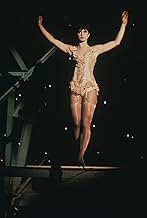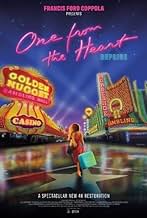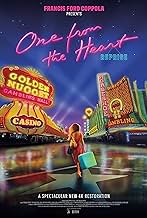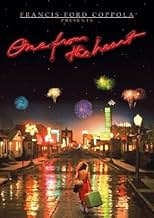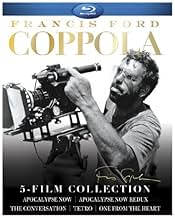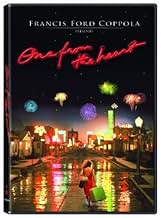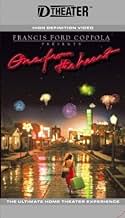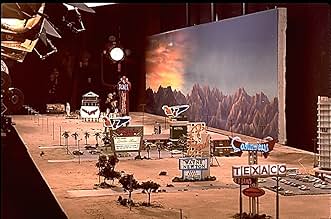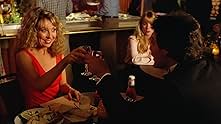AVALIAÇÃO DA IMDb
6,5/10
8,7 mil
SUA AVALIAÇÃO
Um casal tem uma briga depois de viverem juntos por cinco anos em Las Vegas. Eles saem e comemoram o 4 de julho, cada um com um novo parceiro.Um casal tem uma briga depois de viverem juntos por cinco anos em Las Vegas. Eles saem e comemoram o 4 de julho, cada um com um novo parceiro.Um casal tem uma briga depois de viverem juntos por cinco anos em Las Vegas. Eles saem e comemoram o 4 de julho, cada um com um novo parceiro.
- Direção
- Roteiristas
- Artistas
- Indicado a 1 Oscar
- 2 indicações no total
Nastassja Kinski
- Leila
- (as Nastassia Kinski)
Allen Garfield
- Restaurant Owner
- (as Allen Goorwitz)
Rebecca De Mornay
- Understudy
- (as Rebecca de Mornay)
Judith Burnett
- Eleanore
- (não creditado)
Avaliações em destaque
Most general accounts of Francis Ford Coppola's work have identified recurrent familial themes, while visually he has come to be understood as something of a guru of the extravagant. However, neither of these positions is entirely sustainable across an oeuvre that on closer inspection discloses considerable formal and thematic scope. If Coppola had by the close of the 1970s figured, understandably enough, that his career was blessed, this, his next venture, would bring about a very hasty and categorical fall from grace. Initially conceived as a modest antidote to the excesses of Apocalypse Now, the project ballooned into an experiment of gargantuan, tragic proportions that subsequently marked an immediate shift in his career to more modest productions.
This Oscar-nominated Vegas-set semi-musical, which led to Coppola's bankruptcy, is an intriguing production but not a good film. From Coppola, the inspired mastermind of The Conversation, Apocalypse Now and the Godfather films, it's a foremost letdown. A movie's innovative technical process is indeterminate. Movies make or break as per the substance of their material. The most miserable thing about this lavish exercise in style is that it has none. It's a tango of elegant and byzantine camera movements filling wonderful sets, and the characters get completely misplaced in the thick. There's never a second in this film when I'm concerned about what's happening to the people in it, and but one moment, a cameo by Allen Goorwitz as a furious coffee shop owner, when I feel that an actor's artlessness successfully slips past Coppola's suffocating panache and into the audience.
The raconteur of The Godfather turns into a pure technician here. There are unsettling congruences between Coppola's fanatical command of this film and the character of Harry Caul, the wiretapper in Coppola's The Conversation, who cared solely about technical outcomes and declined to let himself consider human ones. Movies are innumerable different things, but most of the best ones are about and for people, and this unmistakably hallucinatory and dreamlike piece of filmmaking takes little notice of the difficulties of the human spirit. Certainly, it appears virtually on the lookout against the actors who inhabit its painstakingly designed scenes. They're scarcely ever permitted to lead. They're figures in a larger blueprint, one that ebbs them, that views them as part of the furnishings. They aren't offered many close-ups. They're frequently suffused in loud red glimmering or overpowering blues and greens. They're positioned before off-puttingly glitzy sets or adrift shoddily stage-managed hordes. And occasionally they're interrupted at the heart of a sentiment because the uncompromisingly planned camera has affairs elsewhere.
I've forgotten, indeed, to mention the players, or who they play. That's not so much of an omission talking about a film like this. The two leads, the sexier-than-ever Teri Garr and the forgettable-as-ever Frederic Forrest occupy a Las Vegas of regret, languor, and glitzy lights. For a short time, they spring from their monotonous lives and meet new lovers, Raul Julia and Natassja Kinski, who string them along with flights of the imagination. In effect, Coppola's telling the simple story of a break-up but with the hyper-romantic lusciousness of the emotions we feel in those times, which is cool, until it becomes an unmotivated, auto-pilot story upstaged by its own, well, stages.
There are trivial amusements in this movie. One is Harry Dean Stanton's phone-in as a sleazy junkyard owner, while Coppola defies showing us Stanton's most valuable instrument, his telling eyes. Kinski, as a circus tightrope walker, has a pretty decent blip on the radar when she explains "to make a circus girl disappear, all you have to do is blink." Garr is endearing, but her role makes her unrewardingly submissive, and Forrest is more or less transparent here, playing such a nonentity. Ho hum.
This Oscar-nominated Vegas-set semi-musical, which led to Coppola's bankruptcy, is an intriguing production but not a good film. From Coppola, the inspired mastermind of The Conversation, Apocalypse Now and the Godfather films, it's a foremost letdown. A movie's innovative technical process is indeterminate. Movies make or break as per the substance of their material. The most miserable thing about this lavish exercise in style is that it has none. It's a tango of elegant and byzantine camera movements filling wonderful sets, and the characters get completely misplaced in the thick. There's never a second in this film when I'm concerned about what's happening to the people in it, and but one moment, a cameo by Allen Goorwitz as a furious coffee shop owner, when I feel that an actor's artlessness successfully slips past Coppola's suffocating panache and into the audience.
The raconteur of The Godfather turns into a pure technician here. There are unsettling congruences between Coppola's fanatical command of this film and the character of Harry Caul, the wiretapper in Coppola's The Conversation, who cared solely about technical outcomes and declined to let himself consider human ones. Movies are innumerable different things, but most of the best ones are about and for people, and this unmistakably hallucinatory and dreamlike piece of filmmaking takes little notice of the difficulties of the human spirit. Certainly, it appears virtually on the lookout against the actors who inhabit its painstakingly designed scenes. They're scarcely ever permitted to lead. They're figures in a larger blueprint, one that ebbs them, that views them as part of the furnishings. They aren't offered many close-ups. They're frequently suffused in loud red glimmering or overpowering blues and greens. They're positioned before off-puttingly glitzy sets or adrift shoddily stage-managed hordes. And occasionally they're interrupted at the heart of a sentiment because the uncompromisingly planned camera has affairs elsewhere.
I've forgotten, indeed, to mention the players, or who they play. That's not so much of an omission talking about a film like this. The two leads, the sexier-than-ever Teri Garr and the forgettable-as-ever Frederic Forrest occupy a Las Vegas of regret, languor, and glitzy lights. For a short time, they spring from their monotonous lives and meet new lovers, Raul Julia and Natassja Kinski, who string them along with flights of the imagination. In effect, Coppola's telling the simple story of a break-up but with the hyper-romantic lusciousness of the emotions we feel in those times, which is cool, until it becomes an unmotivated, auto-pilot story upstaged by its own, well, stages.
There are trivial amusements in this movie. One is Harry Dean Stanton's phone-in as a sleazy junkyard owner, while Coppola defies showing us Stanton's most valuable instrument, his telling eyes. Kinski, as a circus tightrope walker, has a pretty decent blip on the radar when she explains "to make a circus girl disappear, all you have to do is blink." Garr is endearing, but her role makes her unrewardingly submissive, and Forrest is more or less transparent here, playing such a nonentity. Ho hum.
"One from the Heart" is the story of two kindred spirits that have to get through a separation just to find out that they belong to each other. I'm sure that many of you have had similar experiences, don't you? It is also a celebration of the Broadway performances, and of the old school cinema, when everything was hand-made. In the background we hear the voices of Tom Waits and Cristal Gayle singing and narrating what we're watching in the screen (or what we're going to watch...) on a jazz or a blues beat.
They made a huge work of edition here and the photography is just awesome (it's no surprise, anyway, for it was Vicente Storaro the one who photographed it).
As for the cast, Terri Garr's performance is just awesome and she looks so sexy (too bad she wasted her talent in second rate comedies), and the eyes of Nastassja Kinski are the most beautiful you'll ever see.
Viva Las Vegas!!! My rate: 7/10
They made a huge work of edition here and the photography is just awesome (it's no surprise, anyway, for it was Vicente Storaro the one who photographed it).
As for the cast, Terri Garr's performance is just awesome and she looks so sexy (too bad she wasted her talent in second rate comedies), and the eyes of Nastassja Kinski are the most beautiful you'll ever see.
Viva Las Vegas!!! My rate: 7/10
There are times a movie's style can overcome it's lack of substance. But not this time. When this movie was released back in the early 80s, it was the eagerly anticipated 'gamechanger' from the maestro himself. Coppola's novel approach to directing and editing using cutting edge technology (at the time) would revolutionize the art of film making. Instead, it was a commercial flop. Audiences found a shallow beauty. A gorgeous girl with clever quips and opening lines, but no real depth or heart.
The biggest problem for me was that the story feels so disjointed. It's a series of beautiful looking vignettes held together by a paper thin plot and flat two dimensional characters. A lot of the scenes feel stilted and over-rehearsed. There's no spontaneity or life.
It's not a complete waste of time, however. It is a beautiful looking movie. Terri Garr and Natasia Kinski look exquisite. There are a lot of interesting and eye catching touches. The set designs are works of art. You might like this if you are in the right mood, and want to see something different. But if you are looking for a coherent narrative, and engaging character development, you might want to pass.
The biggest problem for me was that the story feels so disjointed. It's a series of beautiful looking vignettes held together by a paper thin plot and flat two dimensional characters. A lot of the scenes feel stilted and over-rehearsed. There's no spontaneity or life.
It's not a complete waste of time, however. It is a beautiful looking movie. Terri Garr and Natasia Kinski look exquisite. There are a lot of interesting and eye catching touches. The set designs are works of art. You might like this if you are in the right mood, and want to see something different. But if you are looking for a coherent narrative, and engaging character development, you might want to pass.
10Canhenha
I have to start by saying that I've had this film on videotape for so long and have seen it so many times that I believe the tape must be damaged by now. I'm a huge fan of Francis Ford Coppola's films, not only his "Godfather" films, but also what he has produced in the 80's and 90's. "One from the Heart" stands as one of most beautiful and poetic art pieces I've seen, ever. He created an entire world on set, something that resembles Vegas, but that I feel, extends a bit beyond that, someplace where love does exist (and Frederic Forrest and Terri Garr are great, because they do represent the average man and woman that want to surpass their mediocrity and have the dream, represented by the late Raul Julia and the gorgeous Nastassja Kinski). The beautiful score by Tom Waits, and the entire dance acts are so wonderfully entwined, that it's impossible not to feel the taste of real cinema there. The cinematography is stunning and I can only sum this up by saying that this film is an incredible experience to watch. Please do so.
Maybe this isn't a masterpiece, but this Las Vegas musical shot entirely on a soundstage was wildly underrated. The film is as daring as any of Coppola's other works. With enjoyable performances and the great Tom Waits/Crystal Gayle songs, slick camera work and colorful neon, there was no reason for this film to get kicked as hard as it did. Who know, maybe it is a masterpiece.
Você sabia?
- CuriosidadesOriginally intended as a small film after the enormous cost, pressures, and production problems of Apocalypse Now (1979), this film's budget ballooned from $2 million to over $25 million. The extraordinary costs led to director Francis Ford Coppola declaring bankruptcy. Coppola has stated that the films he made were done to pay off the debts incurred producing this film.
- Erros de gravaçãoWhen Hank removes Frannie from Ray's room, Ray puts on a robe, and he is not wearing any underwear. However, after Ray yells at Hank from the balcony, his robe falls open, and he is shown wearing jockey shorts.
- Cenas durante ou pós-créditosIn the opening credits, the names of crew members appear in the neon signs of Vegas casinos and hotels.
- Versões alternativasThree versions exist. The theatrical version; 103 minutes The restored version, release in 2003; 99 minutes Reprise version, release in 2023; 93 minutes The story is generally the same. But they have many changes, cut or altered shot.
Principais escolhas
Faça login para avaliar e ver a lista de recomendações personalizadas
- How long is One from the Heart?Fornecido pela Alexa
Detalhes
- Data de lançamento
- País de origem
- Central de atendimento oficial
- Idiomas
- Também conhecido como
- Una del corazón
- Locações de filme
- Empresa de produção
- Consulte mais créditos da empresa na IMDbPro
Bilheteria
- Orçamento
- US$ 26.000.000 (estimativa)
- Faturamento bruto nos EUA e Canadá
- US$ 697.872
- Fim de semana de estreia nos EUA e Canadá
- US$ 389.249
- 14 de fev. de 1982
- Faturamento bruto mundial
- US$ 719.534
- Tempo de duração
- 1 h 47 min(107 min)
- Cor
- Proporção
- 1.37 : 1
Contribua para esta página
Sugerir uma alteração ou adicionar conteúdo ausente



